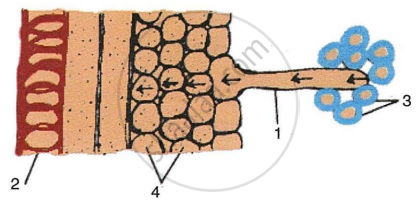Advertisements
Advertisements
Question
Differentiate between the following:
Turgidity and Flaccidity
Solution
| Turgidity | Flaccidity | ||
| 1. | It is the state of a cell in which the cell cannot accommodate any more water and is fully distended. | 1. | It is the condition in which the cell content is shrunken and the cell is not tight. |
| 2. | The availability of sufficient water causing the cells to become charged with water with its walls in a state of tension making the cells rigid and stretched. | 2. | The unavailability of sufficient water causes the cells to become weak and soft due to decreased turgor pressure. |
| 3. | This condition causes wilting in plants. | 3. | This condition makes plants stiff and erect. |
APPEARS IN
RELATED QUESTIONS
Give the equivalent term for the following:
The condition in which the cell contents are shrunken.
Differentiate between the following:
Turgor pressure and wall pressure
What is the difference between ‘flaccid’ and ‘turgid’? Give one example of flaccid condition in plants.
Distinguish between the following:
Flaccid condition and turgid condition
Give Technical Term for the following.
A cell in a fully extended condition.
Name the following:
The process by which wilting or drooping of leaves occurs.
Fill in the Blank
The condition opposite to turgid is ___________.
The hydrostatic pressure of the cell sap on the cell wall is called ______.
Give the equivalent term for the following:
Pressure exerted by the cell contents on the cell wall.
The figure given below is a diagrammatic representation of a part of the cross-section of the root in the root hair zone. Study the same and then answer the questions that follow:

- The parts labelled as 1, 2, 3 and 4 are:
- Root hair, Xylem vessel, Soil particles, Cortex respectively.
- Xylem vessel, Soil particles, Root hair, Cortex respectively.
- Root hair, Xylem vessel, Cortex, Soil particles respectively.
- Cortex, Soil particles, Xylem vessel, Root hair respectively.
- The process that enables the passage of water from soil into the root hair is:
- Diffusion
- Active transport
- Osmosis
- Passive absorption
- The kind of force which exists between a liquid and any surface is called as:
- Cohesive force
- Adhesive force
- Capillarity
- Suction force
- The kind of force between the same kind of liquid molecules is:
- Capillary force
- Transpirational pull
- Adhesive force
- Cohesive force
- Sometimes exudation of water occurs from the margin of the leaves in the early morning or night. It is termed as:
- Transpiration
- Guttation
- Bleeding
- Osmosis
